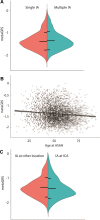Genetic Risk Score for Intracranial Aneurysms: Prediction of Subarachnoid Hemorrhage and Role in Clinical Heterogeneity
- PMID: 36655558
- PMCID: PMC9951795
- DOI: 10.1161/STROKEAHA.122.040715
Genetic Risk Score for Intracranial Aneurysms: Prediction of Subarachnoid Hemorrhage and Role in Clinical Heterogeneity
Abstract
Background: Recently, common genetic risk factors for intracranial aneurysm (IA) and aneurysmal subarachnoid hemorrhage (ASAH) were found to explain a large amount of disease heritability and therefore have potential to be used for genetic risk prediction. We constructed a genetic risk score to (1) predict ASAH incidence and IA presence (combined set of unruptured IA and ASAH) and (2) assess its association with patient characteristics.
Methods: A genetic risk score incorporating genetic association data for IA and 17 traits related to IA (so-called metaGRS) was created using 1161 IA cases and 407 392 controls from the UK Biobank population study. The metaGRS was validated in combination with risk factors blood pressure, sex, and smoking in 828 IA cases and 68 568 controls from the Nordic HUNT population study. Furthermore, we assessed association between the metaGRS and patient characteristics in a cohort of 5560 IA patients.
Results: Per SD increase of metaGRS, the hazard ratio for ASAH incidence was 1.34 (95% CI, 1.20-1.51) and the odds ratio for IA presence 1.09 (95% CI, 1.01-1.18). Upon including the metaGRS on top of clinical risk factors, the concordance index to predict ASAH hazard increased from 0.63 (95% CI, 0.59-0.67) to 0.65 (95% CI, 0.62-0.69), while prediction of IA presence did not improve. The metaGRS was statistically significantly associated with age at ASAH (β=-4.82×10-3 per year [95% CI, -6.49×10-3 to -3.14×10-3]; P=1.82×10-8), and location of IA at the internal carotid artery (odds ratio=0.92 [95% CI, 0.86-0.98]; P=0.0041).
Conclusions: The metaGRS was predictive of ASAH incidence, although with limited added value over clinical risk factors. The metaGRS was not predictive of IA presence. Therefore, we do not recommend using this metaGRS in daily clinical care. Genetic risk does partly explain the clinical heterogeneity of IA warranting prioritization of clinical heterogeneity in future genetic prediction studies of IA and ASAH.
Keywords: aneurysmal subarachnoid hemorrhage; genetic heterogeneity; genetics; intracranial aneurysm; risk assessment.
Figures



Comment in
-
Novel Polygenic Risk Score for Intracranial Aneurysms.Stroke. 2023 Mar;54(3):819-820. doi: 10.1161/STROKEAHA.122.041807. Epub 2023 Jan 19. Stroke. 2023. PMID: 36655556 Free PMC article. No abstract available.
References
-
- Nieuwkamp DJ, Setz LE, Algra A, Linn FH, de Rooij NK, Rinkel GJ. Changes in case fatality of aneurysmal subarachnoid haemorrhage over time, according to age, sex, and region: a meta-analysis. Lancet Neurol. 2009;8:635–642. doi: 10.1016/s1474-4422(09)70126-7 - PubMed
-
- Bakker MK, van der Spek RAA, van Rheenen W, Morel S, Bourcier R, Hostettler IC, Alg VS, van Eijk KR, Koido M, Akiyama M, et al. . Genome-wide association study of intracranial aneurysms identifies 17 risk loci and genetic overlap with clinical risk factors. Nat Genet. 2020;52:1303–1313. doi: 10.1038/s41588-020-00725-7 - PMC - PubMed
-
- Bakker MK, Ruigrok YM. Genetics of intracranial aneurysms. Stroke. 2021;52:3004–3012. doi: 10.1161/strokeaha.120.032621 - PubMed
-
- Vlak MH, Rinkel GJ, Greebe P, Algra A. Independent risk factors for intracranial aneurysms and their joint effect: a case-control study. Stroke. 2013;44:984–987. doi: 10.1161/strokeaha.111.000329 - PubMed
-
- Etminan N, Chang HS, Hackenberg K, de Rooij NK, Vergouwen MDI, Rinkel GJE, Algra A. Worldwide incidence of aneurysmal subarachnoid hemorrhage according to region, time period, blood pressure, and smoking prevalence in the population: a systematic review and meta-analysis. JAMA Neurol. 2019;76:588–597. doi: 10.1001/jamaneurol.2019.0006 - PMC - PubMed
Publication types
MeSH terms
Grants and funding
LinkOut - more resources
Full Text Sources
Medical

